How to improve your website (with AI)
Have you created any website content with ChatGPT and other AI-powered tools yet?
I consider AI as my creative buddy. My buddy won’t save me if I’m entirely clueless about the topic, but it makes me a much more efficient writer and marketer.
No more writer’s block. No second-guessing if there are alternative phrases. AI is always there for me to review my writing, make it easier for others to read my stories, and help me strike the perfect tone.
Your website deserves a creative buddy, too. A content optimization tool that continuously improves the user experience and is always looking out for improvements on your behalf.
In this blog post, I’ll walk you through some tips and techniques on how to improve your website with AI and some of my favourite tools.
Write better content with AI writing tools
One of the misconceptions I hear often is that AI is entirely replacing writers. My friends might ask why I wouldn’t just ask ChatGPT to write everything.
While AI writing tools make it much faster for me to write chunks of content – and especially rephrase the sentence I just wrote – AI services won’t be able to work on the strategy and nuances relevant to my business.
For example, a shop selling cupcakes, cookies, and birthday cakes might have a blog post teaching how to cut a cake for a party. AI will be able to create the structure of the content, but your job as a writer is to make sure the content builds engagement with your brand and drives visitors to your shop. As crazy as it might sound, a blog post on how to cut a cake for a party might not drive any visits to a cake shop – unless the shop sells cake-cutting tools or the writer otherwise connects the dots between the blog post content and the shop.
How does AI help you write better content and improve your website?
Here are a few suggestions.
Publish new content more often
With AI embedded in every part of my writing process, I can publish content a lot more often and faster than I did previously.
To give you an example, I might have limited knowledge about a specific topic, and even if I do my research and read the top Google search results, I still need to find alternative ways of describing things. I simply don’t have years of experience in a specific domain and industry where I would have been exposed to client conversations, event talks, and other interactions with topic experts.
That’s when tools like Jasper can help. It quickly transforms your initial ideas into a longer text, using phrases you would not have necessarily come up with.
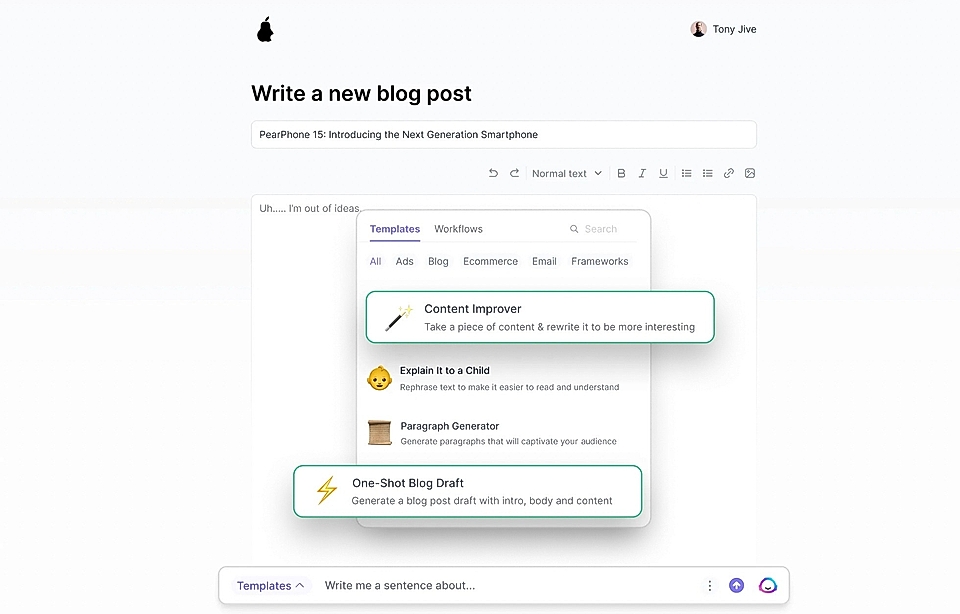
If you have a limited budget, log in to Microsoft’s Copilot to use ChatGPT for free.
Keep the existing content up-to-date
One example of website improvement tasks is to update your existing pages. We naturally tend to focus on the new projects at hand – and unfortunately, we might not show the same appreciation for old content.
For example, I might have used statistics that need to be updated, and the case studies are no longer relevant this year. Or perhaps technology has evolved so much that my content won’t match reality any longer. This might happen to this blog post very soon as AI evolves so rapidly.
With AI tools, you can improve your website and update content much more efficiently. If any specific part of the blog post needs to be updated, you can do research much faster with ChatGPT and replace specific paragraphs based on the suggestions.
There are two reasons why you should update your existing content regularly. The more accurate and current information, your readers will be more satisfied and engaged. Secondly, regular updates keep search engines happy and show you in top positions. Regular content updates are very valuable website improvements.
Remove jargon and unnecessary content
One of the most typical issues for homepages and SaaS landing pages is jargon and unnecessary long content. For example, your website might use language that isn’t too clear for first-time visitors and for people unfamiliar with product details or the industry.
Luckily, this is the easiest website improvement to make – with AI tools.
Some more sophisticated tools warn you automatically if the content is too complex and lengthy for an ordinary reader. I’m a big fan of Grammarly, which automatically gives me instant feedback and streamlines my writing.
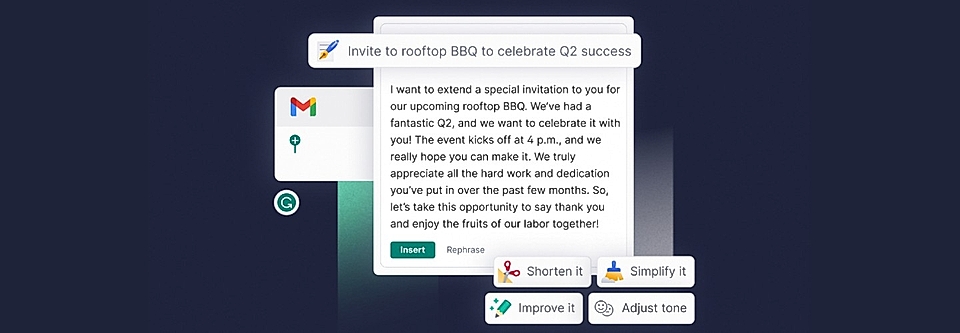
If you don’t have access to premium tools, copy and paste the text to Microsoft Copilot or ChatGPT and ask it to explain the content for a 10-year-old or to summarize it. You can try different prompts to see the difference between your content and the one accessible for all types of audiences.
Be original
It might sound strange to hear that AI helps you be original. But let me explain.
Writers like me read a lot, and I often see SaaS landing page copywriting that I like. Then, subconsciously, I might add similar sentences or sayings here and there. It’s not on purpose; it’s a natural thing to do.
AI can help you improve your website and be original at the same time.
You can, for example, ask ChatGPT to analyze your texts and identify common themes and repetitive sayings. After recognizing similarities, create variations with AI to get inspiration for your next copywriting task.
You might also ask AI tools to write with a different tone or style (such as poetry). The best thing about these tools is that you’ll get an instant reply and inspirational examples to work on further.
Create engaging images and videos
If there’s one thing I’ve struggled with when writing blog posts and designing landing pages, it is to source high-quality images. With a limited marketing budget, I haven’t had access to designers or photographers to create something bespoke for each landing page and campaign.
Up until very recently, my go-to-destination has been Unsplash. From Unsplash, I can typically find decent images, and with some editing, they often look just fine.
It has been time-consuming to find the right ones, though.
Improving website images has become much easier after DALL-E and other generative AI models were released.
In one of my recent blog posts, I had to come up with an image comparing two versions of a webshop – one with a pink and another one with a green theme.
Here’s the image DALL-E generated:
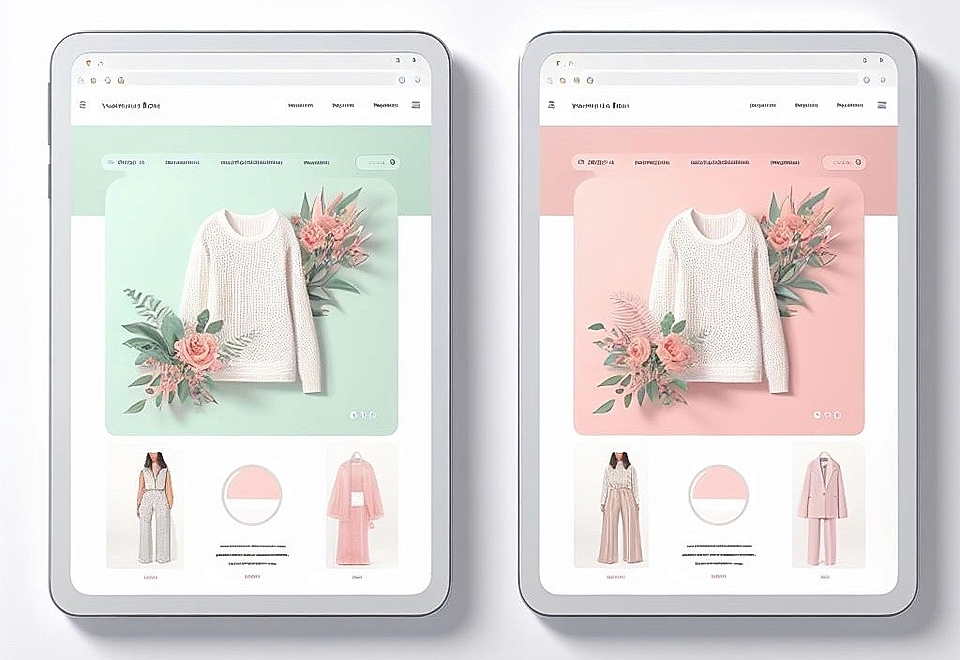
Would you have guessed the image is fully AI-generated?
For now, it takes a few trials and errors to get the prompt right for your image.
AI truly shines today when you ask it to create variations of the image. Tools like Photoroom make creating new versions of the image incredibly easy. For example, if you are running a webshop, you can use Photoroom to place your product in front of a different background.
Improve the website’s SEO with automated audits
I’m a big fan of SEO – it allows me to find an audience for any product without spending money on advertising.
There are quite a few ways SEO can improve your website, and AI-powered tools can assist in the process, but I’ll focus on the most important ones for now.
Optimize content for SEO
One of the most popular types of AI startups is SEO-friendly writing tools.
Existing SEO tools and many new startups have built features that help marketers analyze their text in real-time to ensure it has all the building blocks of SEO-friendly content.
One of my favourites is SEO.ai, which helps you research related keywords, create the blog’s structure, and write the content. AI is embedded in each part of the writing workflow – but I’m in full control and leading the process.
Find content gaps
Have you ever tried the “find content gaps” feature in one of the SEO tools?
It’s brilliant! Finding and filling in content gaps is a fantastic way of improving your website.
I’ll ask an SEO tool to compare my domain and two to three competitors for all the companies I work with. I’ll pick competitors that I believe have the most advanced content marketing strategy and then ask the SEO tool to compare our rankings and the top keywords we are using.
I always find topics and keywords that I have yet to realise are missing from my site entirely, and I can ask those tools to generate similar topics to cover. Then, it’s my job to determine whether my target audience is also missing that content and what my take on the topic is compared to my competitors.
Make your website accessible
One of the most crucial website improvement tasks is to ensure your sites are accessible to all audiences. Not only will it improve your SEO ranking, but you will also see growing conversion rates, increased user engagement, and higher customer satisfaction.
AccessiBe is one of the leading companies in this space. With their AI-powered solution, AccessiBe can uncover issues that a traditional accessibility testing tool – or even the human eye – can’t find.

Get actionable insights from analytics
Shall I mention Google Analytics 4 here? Many marketers are unhappy with it. The sunset of Universal Analytics has made website improvement projects harder than ever before.
But let’s be honest – life wasn’t that easy with Universal Analytics and other alternatives, either. Logging in to any analytics platform usually sucks.
But AI is here for the rescue.
I’ve recently signed up for NarrativeBI, a platform with a simple slogan and promise: “Narrative BI is a generative analytics platform that automatically turns raw data into actionable narratives.”
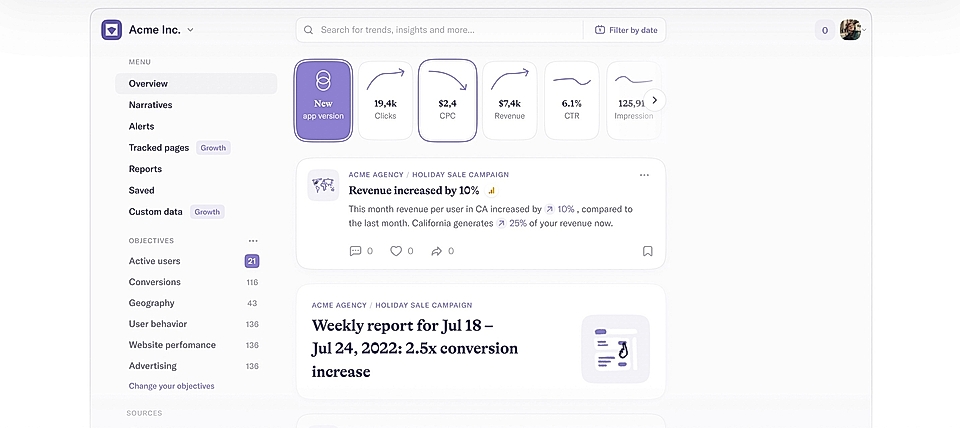
It really does.
So, instead of looking at your Google Analytics 4 dashboard and trying to search for the right data and then turn it into management reports, I’ll get a ready-made summary and alerts in human language.
More insights, less data silos.
Personalize for each visitor
The most straightforward form of website personalization I’ve built for my company is the pricing page currencies based on users’ location. If you visit a page from the U.S., you’ll see prices in USD – regardless of my company’s location. It’s a simple but incredibly powerful thing which increases conversion rates instantly.
On a more sophisticated level, personalization is based on user actions on your website. While personalization is actually built for segments and not for an individual, changing the website content to match the user’s behaviour is an excellent way of improving the website user experience.
For example, depending on the search keyword and Google Ads campaign, you could show a different text. Suppose you can build dynamic landing pages where the text is modified slightly based on the user journey. In that case, you will increase conversion and save costs by building fewer landing page variations.
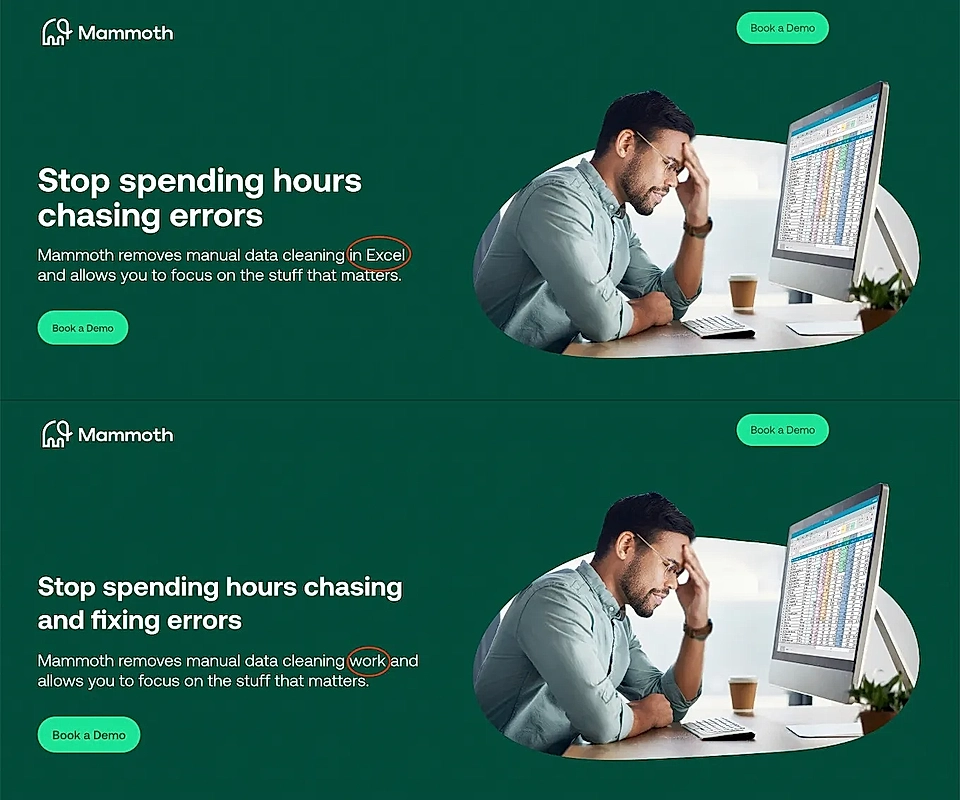
Another great example of personalization is “you might also like” elements. Those might appear at the checkout page on a webshop – based on your browsing history and actions on that specific site.
Add social proof to convince your visitors
Have you ever bought something only because you saw an influencer or another customer recommending it?
It’s not too long ago when I was looking to purchase a desk, and I was browsing the internet to find the best option to fit my small(ish) living room. An image from someone else’s home eventually convinced me to buy the desk. The image made it so much easier for me to see the desk in context – and then purchase!
The most successful companies use social proof to improve their websites.
One of my favourite websites with social proof is Sohome’s webshop, which has a shoppable Instagram gallery.

AI has taken social proof to another level. Recently, we’ve seen Instagram influencers – fully AI-powered – gather a massive following and make money on advertising and affiliates.
It won’t be easy to tell if the influencer is real or AI-generated – but does it really matter?
Test, Test, Test
Finally, the most essential part of improving your website: test, test, test!
When did you last try a different website hero section?
If your answer is I don’t remember, the chances are it’s time for you to start experimenting.
And not only testing homepage titles and taglines but also all parts of your website that receive a decent amount of traffic.
You’ll get a headstart by using the techniques, tips, and tools listed in this blog and making some of the improvements a regular activity.
If you’d like to go a step further, sign up for a heat mapping and A/B testing tool like CrazyEgg.
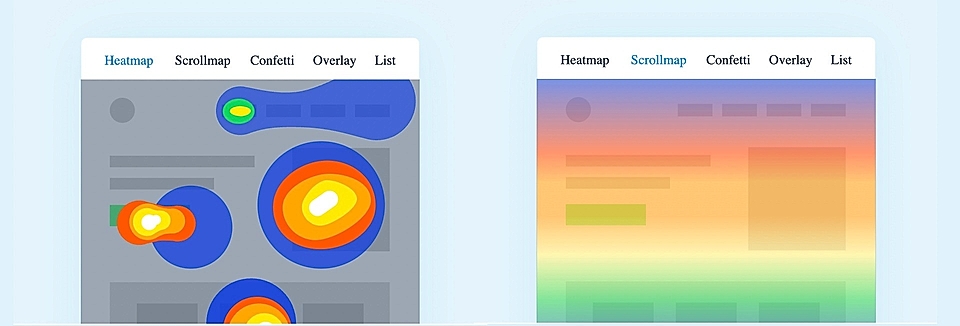
Firstly, you can see how website users navigate your site and what they click (heat map). Heat maps will help you list critical website improvements.
And secondly, you can set up an A/B test for a variation of an element. For example, generate many alternative hero titles with ChatGPT and then run a test with the best alternative against your current one.
Some website builders have built-in capabilities for A/B testing – check them first before signing up for CrazyEgg or one of the similar solutions.
Finally, with tools like LandingRabbit and in a few minutes, you are able to create targeted and high-converting landing pages to match the search intent.
Conclusion
AI has an answer to many of the questions and challenges on how to improve your website. For now, a marketer like me is sitting firmly in the driver’s seat, but AI is already a key component in each part of my website improvement workflow. Soon, AI will be optimizing my websites while I sleep.